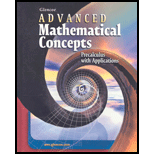
Concept explainers
a.
To find: equation of slope-intercept form for the lines that represent each value change.
a.
Answer to Problem 34E
Explanation of Solution
Given information:
The given information is as follows:
| Stock Index March, 2004 | |
| Day ( | Closing value ( |
| 15 | 1939.20 |
| 16 | 1943.09 |
| 17 | 1976.76 |
| 18 | 1962.44 |
| 19 | 1940.47 |
Calculation:
Let the point coordinates be as follows:
The four lines representing each value change will be
The formula used for solving this problem is as follows:
Now, put the values
Put the slope value of
Substitute the slope value and b for
Now, put the values
Put the slope value of
Substitute the slope value and b for
Now, put the values
Put the slope value of
Substitute the slope value and b for
Now, put the values
Put the slope value of
Substitute the slope value and b for
Thus, the equation for each value change is as follows:
b.
To find: the term indicating the same rate change for two pair of days, and also find whether the rate change is same for any of the given days.
b.
Answer to Problem 34E
Slope indicates the same the rate of change for the two pair of days.
The rate of change was not the same for any day shown because no two slopes in the equation of value change are the same.
Explanation of Solution
Given information:
The given information is as follows:
| Stock Index March, 2004 | |
| Day ( | Closing value ( |
| 15 | 1939.20 |
| 16 | 1943.09 |
| 17 | 1976.76 |
| 18 | 1962.44 |
| 19 | 1940.47 |
Calculation:
The equation for each value change evaluated in problem a. is as follows:
The slope would indicate whether or not the rate of change for two pairs of days was the same.
Here, the slope is the same as the rate of change.
Since, no two slopes in the equation of value change are the same. Therefore, the rate of change was not the same for any day shown.
c.
To predict: the closing value for Day 22, and also explain whether any equation correctly predict this value.
c.
Answer to Problem 34E
The predicted closing values for day 22 are as follows:
Since the actual value of y i.e. 1909.90 do not match with anyone of the predicted value So, no equation matches the value accurately.
Explanation of Solution
Given information:
The given information is as follows:
| Stock Index March, 2004 | |
| Day ( | Closing value ( |
| 15 | 1939.20 |
| 16 | 1943.09 |
| 17 | 1976.76 |
| 18 | 1962.44 |
| 19 | 1940.47 |
Actual closing value ( y ) = 1909.90
Given day ( x ) = 22
The equations are as follows:
Calculation:
Put the value of x in equation (1) and evaluate the value of y as shown below.
Put the value of x in equation (2) and evaluate the value of y as shown below.
Put the value of x in equation (3) and evaluate the value of y as shown below.
Put the value of x in equation (4) and evaluate the value of y as shown below.
Therefore, the predicted closing values for day 22 are as follows:
Since the actual value of y i.e. 1909.90 do not match with anyone of the predicted value but it come closer to (3) equation. By looking on the data, we can say that none of the equation matches the value accurately.
Chapter 1 Solutions
Advanced Mathematical Concepts: Precalculus with Applications, Student Edition
Additional Math Textbook Solutions
Thomas' Calculus: Early Transcendentals (14th Edition)
Single Variable Calculus: Early Transcendentals (2nd Edition) - Standalone book
Calculus: Early Transcendentals (3rd Edition)
University Calculus: Early Transcendentals (3rd Edition)
Calculus and Its Applications (11th Edition)
 Calculus: Early TranscendentalsCalculusISBN:9781285741550Author:James StewartPublisher:Cengage Learning
Calculus: Early TranscendentalsCalculusISBN:9781285741550Author:James StewartPublisher:Cengage Learning Thomas' Calculus (14th Edition)CalculusISBN:9780134438986Author:Joel R. Hass, Christopher E. Heil, Maurice D. WeirPublisher:PEARSON
Thomas' Calculus (14th Edition)CalculusISBN:9780134438986Author:Joel R. Hass, Christopher E. Heil, Maurice D. WeirPublisher:PEARSON Calculus: Early Transcendentals (3rd Edition)CalculusISBN:9780134763644Author:William L. Briggs, Lyle Cochran, Bernard Gillett, Eric SchulzPublisher:PEARSON
Calculus: Early Transcendentals (3rd Edition)CalculusISBN:9780134763644Author:William L. Briggs, Lyle Cochran, Bernard Gillett, Eric SchulzPublisher:PEARSON Calculus: Early TranscendentalsCalculusISBN:9781319050740Author:Jon Rogawski, Colin Adams, Robert FranzosaPublisher:W. H. Freeman
Calculus: Early TranscendentalsCalculusISBN:9781319050740Author:Jon Rogawski, Colin Adams, Robert FranzosaPublisher:W. H. Freeman
 Calculus: Early Transcendental FunctionsCalculusISBN:9781337552516Author:Ron Larson, Bruce H. EdwardsPublisher:Cengage Learning
Calculus: Early Transcendental FunctionsCalculusISBN:9781337552516Author:Ron Larson, Bruce H. EdwardsPublisher:Cengage Learning





